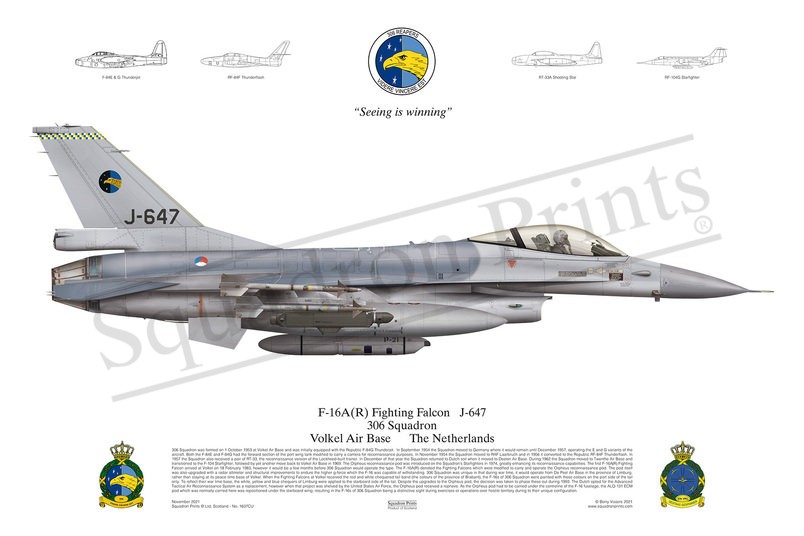#1637CU 306 Sqn, F-16A(R) Fighting Falcon Squadron Print

Description
Squadron Prints Lithograph No. 1637CU - J-647, F-16A(R) Fighting Falcon, 306 Squadron, Volkel Air Base, The Netherlands.
306 Squadron was formed on 1 October 1953 at Volkel Air Base and was initially equipped with the Republic F-84G Thunderjet. In September 1954 the Squadron moved to Germany where it would remain until December 1957, operating the E and G variants of the aircraft. Both the F-84E and F-84G had the forward section of the port wing tank modified to carry a camera for reconnaissance purposes. In November 1954 the Squadron moved to RAF Laarbruch and in 1956 it converted to the Republic RF-84F Thunderflash. In 1957 the Squadron also received a pair of RT-33, the reconnaissance version of the Lockheed-built trainer. In December of that year the Squadron returned to Dutch soil when it moved to Deelen Air Base. During 1962 the Squadron moved to Twenthe Air Base and transitioned to the F-104 Starfighter, followed by yet another move back to Volkel Air Base in 1969. The Orpheus reconnaissance pod was introduced on the Squadron’s Starfighters in 1974, greatly enhancing its reconnaissance capabilities. The first F-16A(R) Fighting Falcon arrived at Volkel on 18 February 1983, however it would be a few months before 306 Squadron would operate the type. The F-16A(R) denoted the Fighting Falcons which were modified to carry and operate the Orpheus reconnaissance pod. The pod itself was also upgraded with a radar altimeter and structural improvements to endure the higher g-force which the F-16 was capable of withstanding. 306 Squadron was unique in that during war time, it would operate from De Peel Air Base in the province of Limburg, rather than staying at its peace time base of Volkel. When the Fighting Falcons at Volkel received the red and white chequered tail band (the colours of the province of Brabant), the F-16s of 306 Squadron were painted with these colours on the port side of the tail only. To reflect their war time base, the white, yellow and blue chequers of Limburg were applied to the starboard side of the tail. Despite the upgrades to the Orpheus pod, the decision was taken to phase these out during 1993. The Dutch opted for the Advanced Tactical Air Reconnaissance System as a replacement, however when that project was shelved by the United States Air Force, the Orpheus pod received a reprieve. As the Orpheus pod had to be carried under the centreline of the F-16 fuselage, the ALQ-131 ECM pod which was normally carried here was repositioned under the starboard wing, resulting in the F-16s of 306 Squadron being a distinctive sight during exercises or operations over hostile territory during to their unique configuration.
